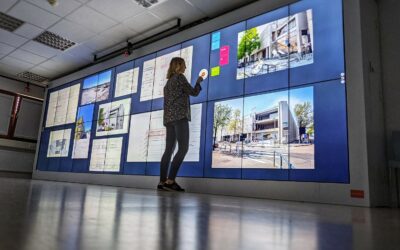Metaverse? Unless you’ve been hibernating for the past four months, you can’t have missed this term.
Metaverse is one of the buzzwords of the beginning of this year, especially since Facebook became Meta and the Californian company decided to orient the future of its activity around this theme.
However, the definition may still be unclear for some. So let’s take the time to explain what it is, what it will change in our lives (potentially) and how Shariiing is taking part in this new (virtual) world.

What is the metaverse?
Let’s lay down the basics. For the purists, a metaverse is a persistent 3D virtual universe, i.e. one that continues to exist even when you leave it. Users communicate in the form of avatars, it is possible to carry out transactions and the whole thing is based on Web3, which prefigures the future of the Internet, a decentralized Internet based on blockchain.
So let’s say it right away, even if Meta (ex-Facebook) is at the origin of the 2021 version of the buzz around the metaverse, this is nothing new and even less an invention of Mark Zuckerberg.
The field of Science-Fiction is full of allusions to metaverse. Some people trace its origins back to the mid-1960s with the novel Simulacron 3, while others cite Snowcrash written in 1992 by Neal Stephenson, which used the term for the first time. Closer to home, Steven Spielberg’s film Ready Player One, based on Ernest Cline’s novel (2011), shows a sophisticated vision of the metaverse on screen.
More concretely, past experiments have attempted to create complex virtual worlds. We can mention Second Life, created in the early 2000s, one of the most popular examples that comes close to the concept of metaverse. Let’s also mention Le Deuxième Monde, a virtual world created by Canal+ Multimédia in 1997, even if this French precursor of Second Life did not have the same success as its American counterpart.
20 years later…
If Second Life still exists, the platforms that are successful today and that best meet the definition of metaverse are called The Sandbox or Decentraland for example. They are regularly talked about since the craze for NFT, with many examples of virtual lands or digital objects bought sometimes millions of euros within these virtual worlds. If this dazzling craze looks like a speculative bubble, market surveys still lead us to believe that the future of metaverse will be flourishing. Gartner recently published a report indicating that in 2026, 25% of the population will spend at least 1 hour a day in the metaverse. If we compare this with the average time spent on the Internet today, this does not seem unlikely. Because the key is there, we must consider metaverse as the future of the current Internet. We will consume, we will play, we will work in metaverses. And Meta has understood this and sees this opportunity as a wonderful reservoir of personal data.

A little something extra
Unlike the platforms mentioned above, Meta is considering its metaverse through the prism of the XR. As the owner of the Oculus brand and manufacturer of Quest headsets, the American company has all the assets in hand to immerse us in its ‘Ready Player One style’ metaverse,.
And it’s not the only one. More discreetly, in 2021, its Chinese counterpart ByteDance, which owns Tik Tok, bought out its compatriot and VR headset maker Pico Interactive. While it has yet to unveil a strategy that really goes the way of Meta, the numbers put forward by Morgan Stanley for the Chinese metaverse, a potential $8 trillion, might make it want to accelerate in that direction. And if the Paiduidao application, « Party Island » in English, recently launched by the social network is not strictly speaking a metaverse, this new 3D virtual world could be one of its bricks.
And Shariiing, in all of this?
Let me stop you! And you’ll probably be disappointed to hear this, but we don’t plan to compete with Meta, ByteDance and Co. on the metaverse field.
The promise of Shariiing is quite different. It consists in bringing people together in the same space, in real life, to encourage exchanges by allowing them to share and interact with all types of digital content on interactive display devices in particular.
Developed by Immersion, a pioneer in XR, Shariiing was designed from the start to integrate 3D, as well as virtual, augmented and mixed reality devices. So obviously, when GAFAM and BATX are interested in XR and the metaverse, it speaks to us, as you can imagine.
In concrete terms, it is already possible, for example, to connect a virtual reality headset to an interactive screen thanks to Shariiing. This is used to visualize the point of view of the person immersed and to add indications from the screen in his helmet to guide him and facilitate communication, regardless of the application. Another example, a user connected remotely with a tablet or a smartphone (and soon with augmented and mixed reality glasses) can communicate in augmented reality with a Shariiing screen for remote assistance. In this type of scenario, the expert can add information from his screen that will be superimposed in the operator’s field of view, to indicate the steps to take.
In short, as you can see, Shariiing is already “VR Ready” or “XR Ready” and I would even say “Metaverse Ready”.
Connecting the real and the virtual
Let me continue. Shariiing relies on face-to-face interactions, based on the principle that 80% of innovative ideas are born in the heart of interpersonal relationships, within the same physical space 1 .
However Shariiing workspace is everything but a bubble where teams work in isolation. On the contrary, Shariiing’s screens are like a bridge between the face-to-face and the remote, between the real and the virtual. Imagine an immersive collaboration space, as Meta proposes with Horizon Workrooms, connected via Shariiing to your meeting room, allowing communication between 3D avatars and real people.
With the advent of metaverse, Shariiing will not only connect our physical workspaces and virtual worlds, but will also offer rich experiences to share information in new and surprising ways between these two universes, further reducing the boundary between the real and the virtual.
If it is still too early to tell you everything, you should know that our R&D team is already working on inventing the future to respond to new ways of working. The future promises to be exciting. And I don’t know about you, but we are eager to get there.
Matthieu Lépine
Brand Ambassador
1 According to Thomas J. Allen, in his book “Managing the Flow of Technology”


